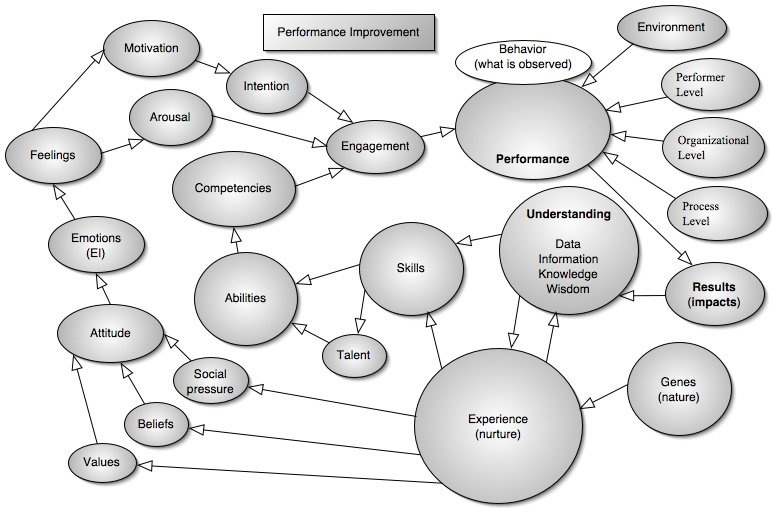Attitude and Performance
Although there are a variety of definitions for attitude, most seem to center around the notion that it involves measuring people, issues, objects, etc. along a dimension ranging from positive to negative. This measurement has two components: 1) cognitive and 2) affective (values & beliefs).
Our beliefs and values are combined with our cognitive component; thus, two components (affective and cognitive) give us our long range or persistent measurements for dealing with the world (Bootzin, 1983). While a person may have the competency to perform a task, that does not mean he or she will have the desire (attitude) to do so correctly. In other words, competencies give us the ability to perform, while attitudes give us the desire to perform. Attitudes change with various events in a person's life. These emotional changes also vary in length of time.
Each human emotion mobilizes the mind and body to meet one of the challenges of living and reproducing in the cognitive niche. Some challenges are posed by physical things, and the emotions that deal with them, like disgust, fear, and appreciation of natural beauty work in straightforward ways. Others are posed by people. The problem in dealing with people is that people can deal back. The emotions that evolved in response to other people's emotions, like anger, gratitude, shame, and romantic love, are played on a complicated chessboard, and they spawn the passion and intrigue that misleads the Romantic. Steven Pinker - How the Mind Works (1997) p.374).
There are four main methods used for changing attitudes in performance interventions:
- Exposure Effect: This technique uses simple experiences to start the attitude formation by exposing a person to a concept, object, or person a number of times. And normally this is done through positive experiences as negative experiences require disgust, pain, or fear. For example, if we want a person to display a smile, then the employee's peers, supervisors, and leaders, need to consistently display real smiles.

- Reinforcement: This concept is based upon classical and operant conditioning. Classical conditioning are involuntary reflexes, while operant conditioning is based upon voluntary behavior. For example, we use classical conditioning by making classrooms attractive and non-threatening. While operant conditional is based upon the premise that people repeat a behavior that has desirable results, for example, when a learner produces a genuine smile, then a compliment, prize, grade, etc. is given.
- Persuasive Communication: The advertisement industry is based upon this technique. For example, Camel cigarettes used information, such as how they use a superior tobacco blend, in combination with Joe Camel, to show how cool they are, in order to persuade people through both their cognitive and emotional sides to buy their product. This technique is based upon three main characteristics: source, message, and audience, e.g.:
- the source — how believable and likable you are
- the message — content and style
- and audience — educational level, other attitudes
- Changing Viewpoints: Although discussions mainly work through our cognitive side, we have to remember that almost everything we do is based upon our emotions. Epictetus wrote, “Men are disturbed not by things but by the views which they take of them.” So you might start a discussion by asking how their feeling are linked to their thoughts. A simple example for training customer service might be to ask them what feelings and thoughts produce a smile? How are these feelings and thoughts interconnected? Next, ask them to take the viewpoint that they are happy when working with customers. Ask them what their feelings and thoughts would be. Finally, have them do a role play of working with a customer with this new viewpoint.
NOTE: In certain organizations or circles, the word “attitude” seems almost mystical and reverent. Often it is almost taboo to discuss. This is because we are often discussing much more than attitudes. That is, we are really discussing a variety of self-concepts" such as values, feelings, emotions, motivations, etc. So instead of discussing skills, knowledge, and attitudes, it might be more appropriate to use the term “self-system” in the place of attitude — an interrelated system of beliefs and processes that produce goals that are executed by the metacognitive system. Specifically, the self-system determines whether an individual will engage in or disengage in a given task (Marzano, 1998).
References
Bootzin, R., Loftus, E., Zajonc, R. (academic advisors) (1983). Psychology Today: An Introduction. New York: Random House. Fifth Edition, p. 570.
Robert J. Marzano, (December 1998). A Theory-Based Meta-Analysis of Research on Instruction. Aurora, Colorado: Mid-continent Regional Educational Laboratory.
Pinker, Steven (1997). How the Mind Works. New York: W. W. Norton & Company.



